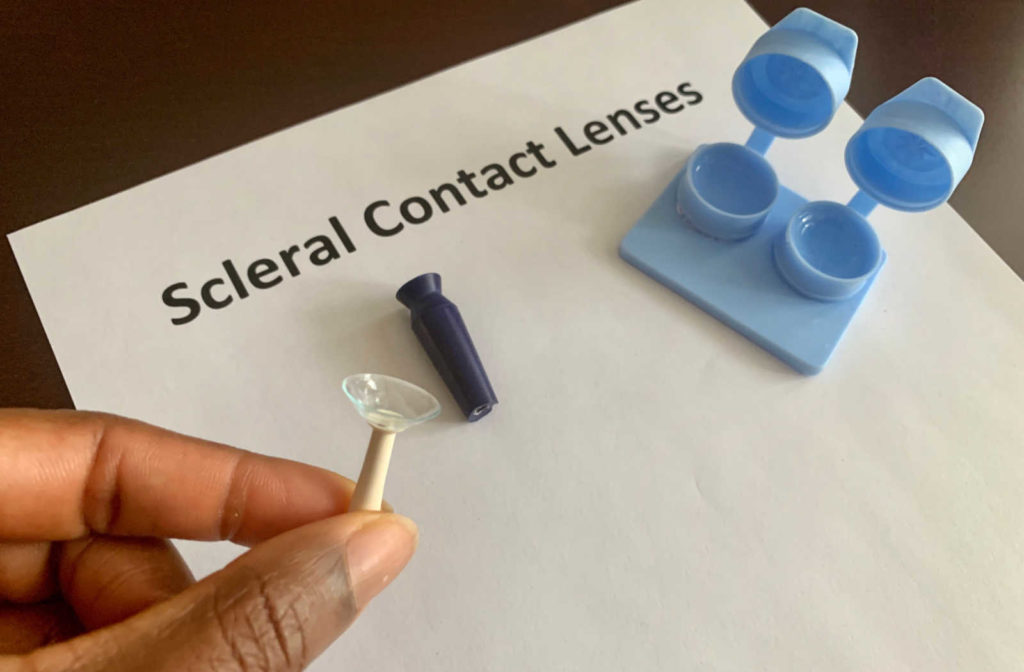Contact lenses are a common solution for people with vision problems. With over 45 million Americans estimated to use contact lenses, you may wonder what specialty options are available for you to make sure your vision is at its best.
There are several different types of specialty contact lenses designed to correct particular issues in the eye. Some of these help with problems such as astigmatism, while others have several different prescriptions built in to help see different distances clearly. By utilizing different shapes, cuts, and materials, specialty lenses can help correct eye issues that normal contact lenses can’t help.
It is always best to consult with an eye care professional to ensure that the contact lenses you buy are the right ones for you.
Scleral Contact Lenses
Regular contact lenses sit on the surface of your eye just over the cornea. They refract light into your eye and help correct your vision just as eyeglasses do. However, all eyes are not the same—if there is an issue with the shape of your eye, or they’re easily irritated, you may need something other than regular contact lenses.
A scleral lens sits on the whites of your eyes (the sclera) and arches over the cornea before resting on your eye. This creates a spherical surface that can properly refract light into your eyes just as your own natural lens would. These are primarily prescribed to people who have a misshapen or irregular cornea.
Ortho-K Contact Lenses
Orthokeratology, or ortho-k, is the use of a contact lens that temporarily reshapes the cornea itself. A good analogy is to think of it like braces for your eyeball, realigning and reshaping your eye so it can properly refract light so you can see clearly. Without glasses or contact lenses during the day making them a nonsurgical alternative to LASIK. They also help control the progression of nearsightedness (myopia) in kids.
These lenses are mostly worn at night while you sleep. Their effects are reversible; if you don’t wear them for a while, your eye will naturally revert to its natural shape. However, if they’re worn as recommended by your optometrist, they can consistently maintain the shape of your eye as needed.

Aspheric Contact Lenses
A regular contact lens has a consistent curve to refract light at the same angle into your eye, no matter how the light hits the lens. However, for people suffering from astigmatism or other problems related to eye shape, these lenses don’t refract light as needed.
An aspheric lens is shaped without a uniform curve. Instead of being shaped like a perfect curve, they feature varying levels of curvature across the lens. They have 2 primary shapes.
Convex Aspheric Lens
This type of aspheric lens is shaped thicker in the center and thinner on the edges. This is often used to help with presbyopia (age-related farsightedness).
Concave Aspheric Lens
These lenses are shaped thinner in the center and thicker on the edges. These are prescribed to help with high myopia (nearsightedness).
Toric Contact Lenses
Toric contact lenses are a more specific type of lens. Most contact lenses are shaped spherically and have the same prescription across the lens to correct vision. Toric lenses are oval in shape to correct for astigmatism.
Therefore, toric lenses are shaped differently. They have a thicker zone in the center along with a center axis (vertical and horizontal). Think of them like a slice taken off the side of a sphere. This thicker zone sits on a predetermined specific spot on your eye and is shaped to refract the exact amount of light necessary.
The prescription power of toric lenses changes depending on how you’re looking through the lens. Due to their shape, the different parts of the lenses will give you the proper prescription to see good with astigmatism.
Multifocal Contact Lenses
Multifocal contact lenses have 2 different prescriptions built into them. One prescription is for near vision, and the other is for viewing things further away. These lenses are specifically designed to counter presbyopia.
Transitional Contact Lenses
Transitional contact lenses work similarly to traditional transitional glasses. They are designed with a specific molecule built into the lens that reacts with exposure to UV light. Simply put, when it’s bright outside, they’ll darken and act just like sunglasses. When it’s darker, they’ll allow more light in for maximum clarity of your vision.
How Do I Know if I Need Specialty Contacts?
It’s best to speak with your eye care professional when thinking about purchasing contacts. They’re a convenient way to help you see clearly, but they are not a one-size-fits-all option.
By consulting with an experienced eye care professional, like the team at Signature Eye Care, you can make an informed choice when you buy your contacts.Book an appointment with the Signature Eye Care team today to discuss your options and learn more about the benefits of specialty contact lenses.



